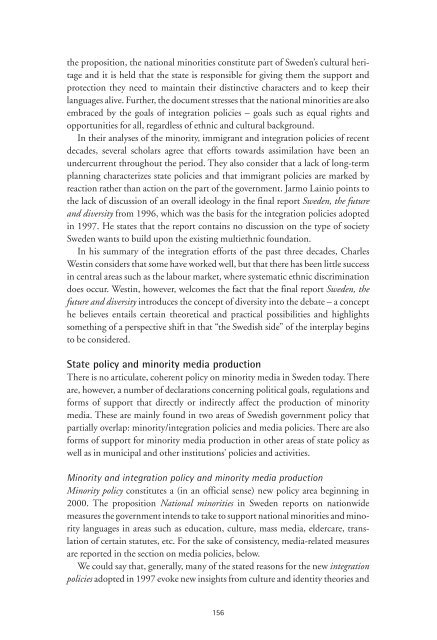Minoritetsmedier och minoritetsmediepolitik i Sverige - Myndigheten ...
Minoritetsmedier och minoritetsmediepolitik i Sverige - Myndigheten ...
Minoritetsmedier och minoritetsmediepolitik i Sverige - Myndigheten ...
Create successful ePaper yourself
Turn your PDF publications into a flip-book with our unique Google optimized e-Paper software.
the proposition, the national minorities constitute part of Sweden’s cultural heritage<br />
and it is held that the state is responsible for giving them the support and<br />
protection they need to maintain their distinctive characters and to keep their<br />
languages alive. Further, the document stresses that the national minorities are also<br />
embraced by the goals of integration policies – goals such as equal rights and<br />
opportunities for all, regardless of ethnic and cultural background.<br />
In their analyses of the minority, immigrant and integration policies of recent<br />
decades, several scholars agree that efforts towards assimilation have been an<br />
undercurrent throughout the period. They also consider that a lack of long-term<br />
planning characterizes state policies and that immigrant policies are marked by<br />
reaction rather than action on the part of the government. Jarmo Lainio points to<br />
the lack of discussion of an overall ideology in the final report Sweden, the future<br />
and diversity from 1996, which was the basis for the integration policies adopted<br />
in 1997. He states that the report contains no discussion on the type of society<br />
Sweden wants to build upon the existing multiethnic foundation.<br />
In his summary of the integration efforts of the past three decades, Charles<br />
Westin considers that some have worked well, but that there has been little success<br />
in central areas such as the labour market, where systematic ethnic discrimination<br />
does occur. Westin, however, welcomes the fact that the final report Sweden, the<br />
future and diversity introduces the concept of diversity into the debate – a concept<br />
he believes entails certain theoretical and practical possibilities and highlights<br />
something of a perspective shift in that “the Swedish side” of the interplay begins<br />
to be considered.<br />
State policy and minority media production<br />
There is no articulate, coherent policy on minority media in Sweden today. There<br />
are, however, a number of declarations concerning political goals, regulations and<br />
forms of support that directly or indirectly affect the production of minority<br />
media. These are mainly found in two areas of Swedish government policy that<br />
partially overlap: minority/integration policies and media policies. There are also<br />
forms of support for minority media production in other areas of state policy as<br />
well as in municipal and other institutions’ policies and activities.<br />
Minority and integration policy and minority media production<br />
Minority policy constitutes a (in an official sense) new policy area beginning in<br />
2000. The proposition National minorities in Sweden reports on nationwide<br />
measures the government intends to take to support national minorities and minority<br />
languages in areas such as education, culture, mass media, eldercare, translation<br />
of certain statutes, etc. For the sake of consistency, media-related measures<br />
are reported in the section on media policies, below.<br />
We could say that, generally, many of the stated reasons for the new integration<br />
policies adopted in 1997 evoke new insights from culture and identity theories and<br />
156

















